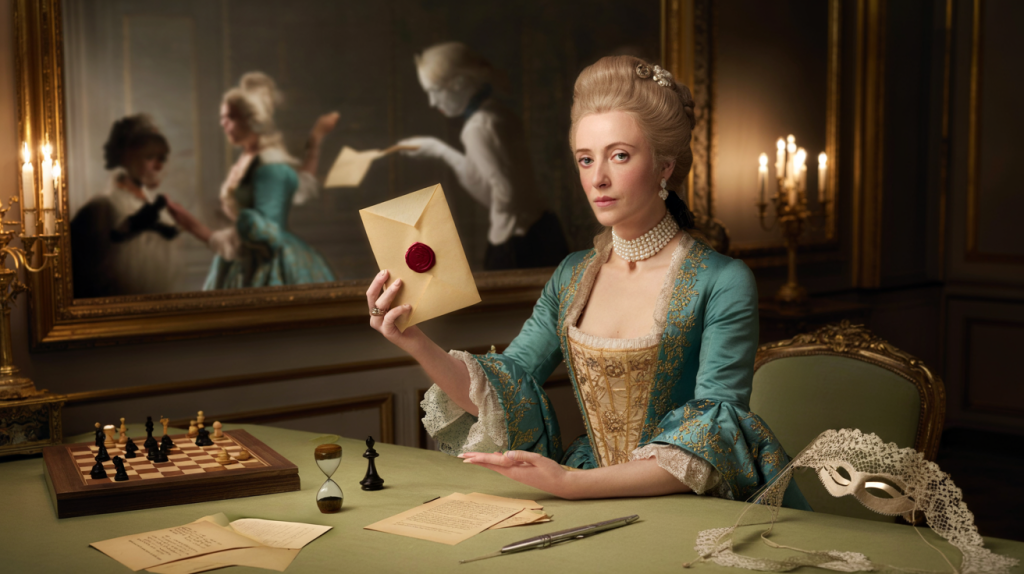She writes, seduces, dismantles – without leaving a fingerprint. Madame de Merteuil powers the engine of Pierre Choderlos de Laclos’s “Les Liaisons dangereuses”, an epistolary novel first published in 1782 and built from 175 letters. Encyclopaedia Britannica lists those core facts, placing the book at the sharp end of 18th century social theater and intrigue (source : Britannica).
The stakes are brutal. Reputation decides everything, and Merteuil understands the rules better than anyone. She orchestrates the libertine Vicomte de Valmont, maps desires like tactics, then pays a price carved into the plot’s final turn : public exposure of her letters and disfigurement by smallpox, a downfall recorded by Britannica along with Valmont’s fatal duel (source : Britannica).
Madame de Merteuil in “Les Liaisons dangereuses” : the mastermind
At the center sits a strategy, not simple villainy. Merteuil designs a life where control covers every gesture, every silence, every carefully phrased line. The novel’s letter-by-letter architecture lets her choreograph scenes she never attends, shaping outcomes through tone, timing, and selective truths.
Readers often search for a single motive. Revenge, desire, wounded pride. The novel makes that hunt slippery on purpose. What stands firm is method: Merteuil treats society like a chessboard, where honesty is a move, not a value. Each letter narrows a margin of risk while widening her margin of maneuver.
The problem to solve: how to read her without flattening her into a one-note monster. The text invites a forensic approach, not a verdict. Track what she says, then what happens next. Cause and effect, line by line.
Laclos, letters et control : how the system works
According to Britannica, the book’s 175 letters sit at the core of its design, a structure that turns gossip into geopolitics of the heart. Epistolary form is not decoration here – it is the weapon. Who writes, when they write, and to whom, becomes the plot itself (source : Britannica).
One detail matters for every close reading: letters create alibis. Because messages move slower than events, the gap between action and report becomes a space where Merteuil works. She anticipates delays, plants versions of the truth, and lets time do part of the damage.
Students stumble in two places: seeing her as pure evil and ignoring etiquette’s iron cage. Reputation rules function like law. Merteuil’s talent is to write within those rules while bending outcomes outside them.
Four quick checks sharpen any reading of Merteuil :
- Map her objectives per relationship, not per chapter.
- Compare the promise inside a letter with the result two letters later.
- Listen for shifts in register – flirtation, legalese, moral piety – each serves a plan.
- Note when she chooses silence. Absence can be the loudest line.
From page to Oscars : the cultural afterlife
Christopher Hampton’s stage adaptation premiered in 1985 with the Royal Shakespeare Company, sending Merteuil’s voice from page to spotlight (source : RSC). Then came the global echo. Stephen Frears’s “Dangerous Liaisons” (1988) turned the text into a cold flame on screen, with Glenn Close, John Malkovich, and Michelle Pfeiffer. The Academy of Motion Picture Arts and Sciences records 7 nominations and 3 wins – a 42.9 percent win rate – including Best Adapted Screenplay, Best Costume Design, and Best Art Direction (source : Oscars.org).
The story kept mutating : Miloš Forman’s “Valmont” (1989), a 2012 Korean-set “Dangerous Liaisons” directed by Hur Jin-ho, the 2022 Starz series, and recent French reimaginations for younger audiences. Different centuries, same core : how desire turns lethal when filtered through status, secrecy, and wit.
Why Madame de Merteuil still resonates : power, gender, consequence
Merteuil’s project reads like a survival blueprint in a world that punishes women for playing the same games men boast about. She builds a persona, then weaponizes it. That self-fashioning looks briliant until the social ecosystem closes ranks and punishes her with spectacle – exposure of letters, ruined face, ruined name. The machine she mastered bites back, and the novel lets us watch the cost.
For readers and learners now, the cleanest path is practical : start with a critical edition that prints the original letter order and provides notes on dating and social codes; pair it with Hampton’s stage text to hear how subtext becomes dialogue; then watch the 1988 film to study how costume and framing translate reputation into images. The triangle of page, stage, and screen turns Merteuil from a legend into a case study you can test – scene by scene, line by line.
Sources : Encyclopaedia Britannica ; Academy of Motion Picture Arts and Sciences ; Royal Shakespeare Company.
